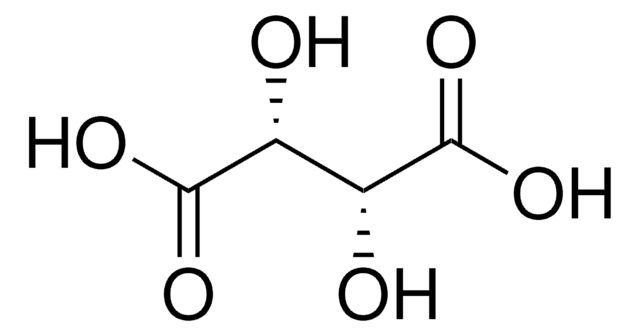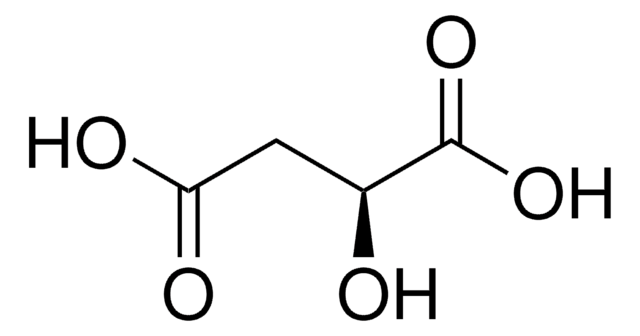33801
L-(+)-Tartaric acid
puriss. p.a., reag. ISO, 99.5-101.0% (calc. to the dried substance)
Sinonimo/i:
(2R,3R)-(+)-Tartaric acid, L-Threaric acid
About This Item
Prodotti consigliati
agenzia
Ph. Eur.
USP/NF
reag. ISO
Livello qualitativo
Densità del vapore
5.18 (vs air)
Grado
puriss. p.a.
Saggio
99.5-101.0% (calc. to the dried substance)
Stato
powder or crystals
Attività ottica
[α]20/D +12.0 to +12.8°, c = 20% in H2O
Temp. autoaccensione
797 °F
Impurezze
≤0.0005% heavy metals (as Pb)
Residuo alla calcinazione
≤0.1% (as SO4)
Perdita
≤0.1% loss on drying, 105 °C
Punto di fusione
170-172 °C (lit.)
Anioni in tracce
chloride (Cl-): ≤5 mg/kg
phosphate (PO43-): ≤10 mg/kg
sulfate (SO42-): ≤150 mg/kg
Cationi in tracce
Ca: ≤20 mg/kg
Cu: ≤5 mg/kg
Fe: ≤5 mg/kg
Pb: ≤2 mg/kg
Zn: ≤5 mg/kg
Stringa SMILE
O[C@H]([C@@H](O)C(O)=O)C(O)=O
InChI
1S/C4H6O6/c5-1(3(7)8)2(6)4(9)10/h1-2,5-6H,(H,7,8)(H,9,10)/t1-,2-/m1/s1
FEWJPZIEWOKRBE-JCYAYHJZSA-N
Cerchi prodotti simili? Visita Guida al confronto tra prodotti
Descrizione generale
Applicazioni
Avvertenze
Danger
Indicazioni di pericolo
Consigli di prudenza
Classi di pericolo
Eye Dam. 1
Codice della classe di stoccaggio
11 - Combustible Solids
Classe di pericolosità dell'acqua (WGK)
WGK 1
Punto d’infiammabilità (°F)
302.0 °F - closed cup
Punto d’infiammabilità (°C)
150 °C - closed cup
Dispositivi di protezione individuale
dust mask type N95 (US), Eyeshields, Gloves
Scegli una delle versioni più recenti:
Possiedi già questo prodotto?
I documenti relativi ai prodotti acquistati recentemente sono disponibili nell’Archivio dei documenti.
I clienti hanno visto anche
Il team dei nostri ricercatori vanta grande esperienza in tutte le aree della ricerca quali Life Science, scienza dei materiali, sintesi chimica, cromatografia, discipline analitiche, ecc..
Contatta l'Assistenza Tecnica.






